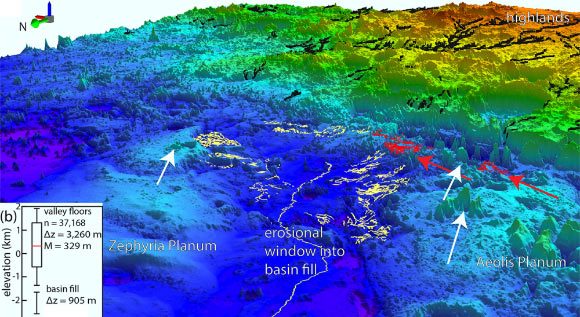A major question in Mars history is whether the planet had an ocean in its northern hemisphere. New research provides evidence for a northern ocean or large sea based on stratigraphic analysis of sedimentary basin fill exposed at Aeolis Dorsa, a trough-like region of Mars about 500 km wide and 900 km long, surrounded east and west by 2 km-high plains and to the south by steep slopes up to the southern hemisphere.

Benjamin Cardenas & Michael Lamb show definitive evidence of a roughly 3.5-billion-year-old shoreline with substantial sedimentary accumulation, at least 900 m thick, that covered hundreds of thousands of square kilometers. Image credit: Benjamin Cardenas / Penn State.
“What immediately comes to mind as one the most significant points here is that the existence of an ocean of this size means a higher potential for life. It also tells us about the ancient climate and its evolution,” said Penn State geoscientist Benjamin Cardenas.
“Based on these findings, we know there had to have been a period when it was warm enough and the atmosphere was thick enough to support this much liquid water at one time.”
“There has long been debate in the scientific community about whether Mars had an ocean in its low-elevation northern hemisphere.”
Using topography data, Dr. Cardenas and his colleague, Caltech’s Dr. Michael Lamb, were able to show definitive evidence of a roughly 3.5-billion-year-old shoreline with substantial sedimentary accumulation, at least 900 m thick, that covered hundreds of thousands of square kilometers.
“The big, novel thing that we did in this paper was think about Mars in terms of its stratigraphy and its sedimentary record,” Dr. Cardenas said.
“On Earth, we chart the history of waterways by looking at sediment that is deposited over time.”
“We call that stratigraphy, the idea that water transports sediment and you can measure the changes on Earth by understanding the way that sediment piles up. That’s what we’ve done here — but it’s Mars.”
The authors discovered over 6,500 km of fluvial ridges and grouped them into 20 systems to show that the ridges are likely eroded river deltas or submarine-channel belts, the remnants of an ancient Martian shoreline.
Elements of rock formations, such as ridge-system thicknesses, elevations, locations and possible sedimentary flow directions helped the team understand the evolution of the region’s paleogeography.
The area that was once ocean is now known as Aeolis Dorsa and contains the densest collection of fluvial ridges on the planet.
“The rocks in Aeolis Dorsa capture some fascinating information about what the ocean was like,” Dr. Cardenas said.
“It was dynamic. The sea level rose significantly. Rocks were being deposited along its basins at a fast rate. There was a lot of change happening here.”
The team’s work appeared this month in the Journal of Geophysical Research: Planets.
_____
Benjamin T. Cardenas & Michael P. Lamb. Paleogeographic Reconstructions of an Ocean Margin on Mars Based on Deltaic Sedimentology at Aeolis Dorsa. Journal of Geophysical Research: Planets, published online October 12, 2022; doi: 10.1029/2022JE007390







